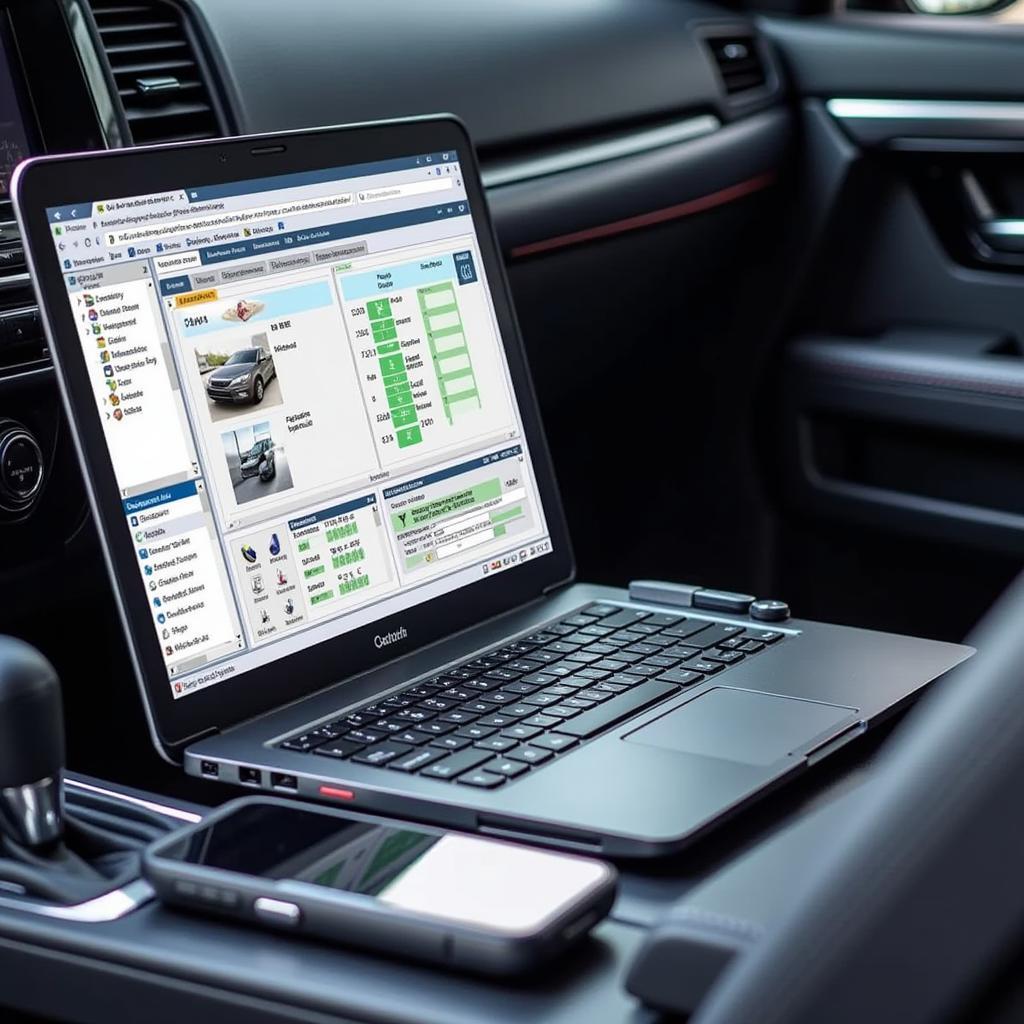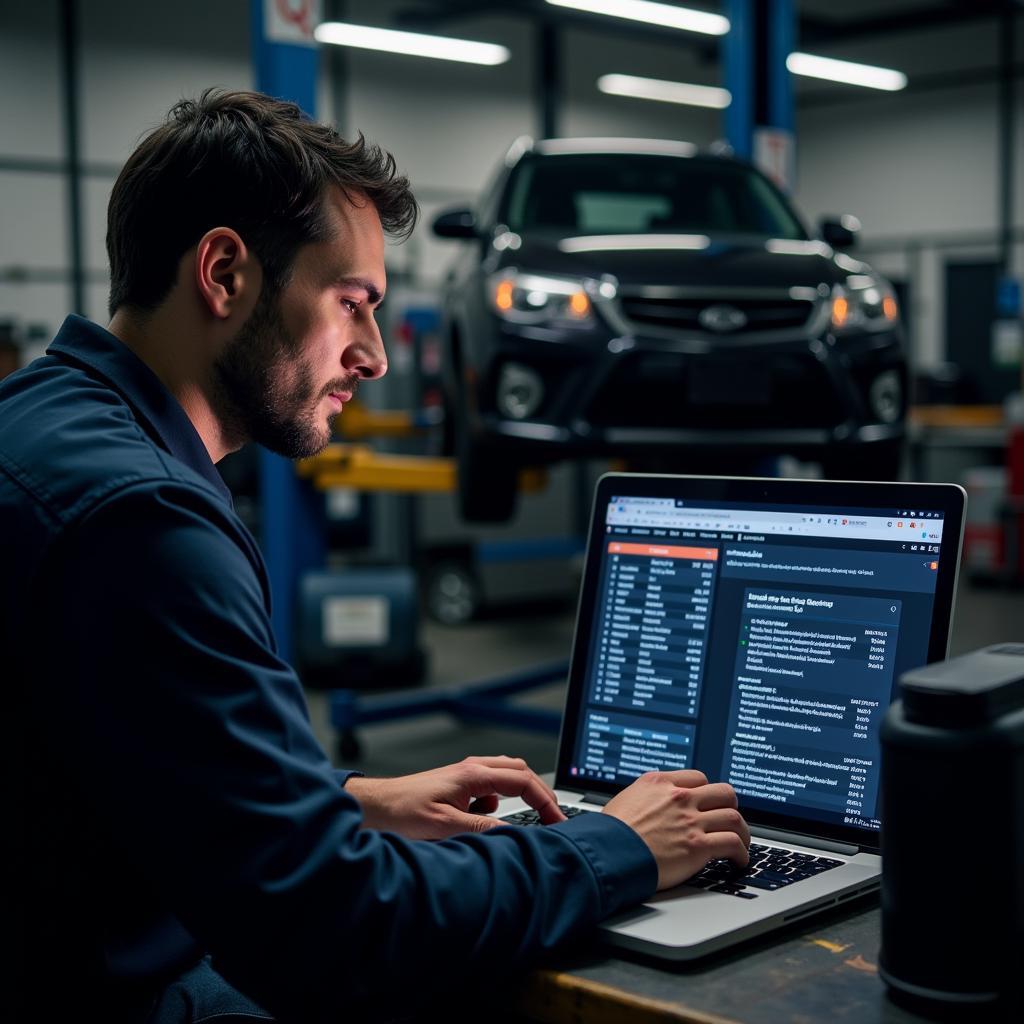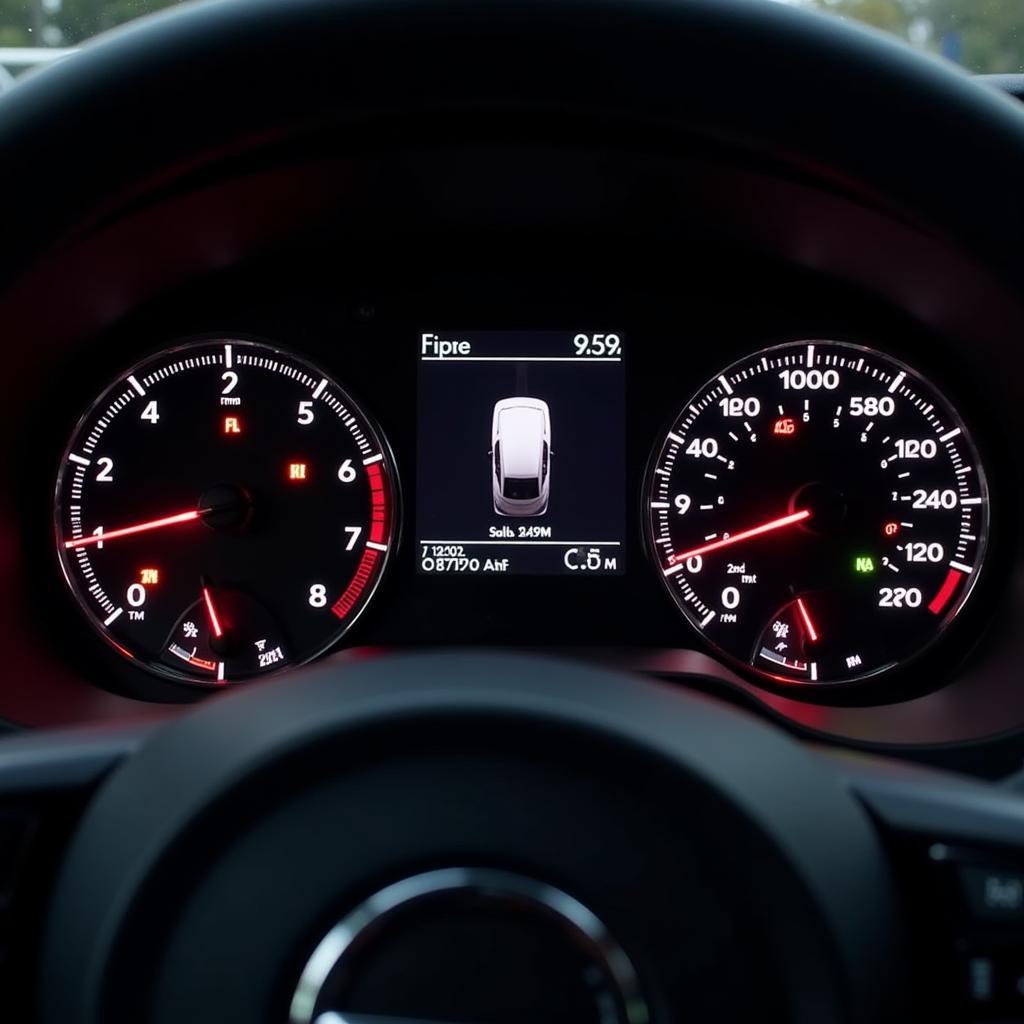In today’s tech-driven world, car diagnostic software for laptops has become an indispensable tool for both car enthusiasts and professional mechanics. No longer a luxury reserved for high-end garages, this software grants access to the inner workings of your vehicle, allowing for accurate diagnosis and even repair in some cases.
 Car diagnostic software displayed on a laptop connected to a car’s OBD-II port
Car diagnostic software displayed on a laptop connected to a car’s OBD-II port
What is Car Diagnostic Software for Laptops?
Car diagnostic software is a program that interfaces with your car’s onboard computer system, typically through the OBD-II port. This software retrieves data from various sensors and systems, providing valuable insights into the health and performance of your vehicle.
Why Choose Car Diagnostic Software for Laptop?
While handheld code readers offer basic functionality, car diagnostic software for laptops provides a significantly more comprehensive and powerful solution.
Advantages of using car diagnostic software on a laptop:
- Advanced Diagnostics: Delve deeper than basic code readers, accessing real-time data streams, live sensor readings, and historical fault codes for in-depth analysis.
- Cost-Effective Solutions: Identify potential issues early on, potentially saving you expensive trips to the mechanic for minor problems you can address yourself.
- Enhanced Customization: Enjoy the flexibility of larger screens, customizable dashboards, and the ability to save, share, and print diagnostic reports.
- Software Updates: Benefit from regular software updates that include new features, wider vehicle compatibility, and access to the latest diagnostic protocols.
Choosing the Right Car Diagnostic Software
Navigating the world of car diagnostic software can be daunting. Here’s what to consider:
1. Vehicle Compatibility:
Ensure the software supports your vehicle’s make, model, and year. Some programs specialize in certain brands or regions, like Indian car diagnostic software for laptop.
2. Functionality:
Determine your needs:
- Basic Code Reading: For simple fault code retrieval and clearing.
- Live Data Streaming: To monitor sensor readings in real-time.
- Component Activation: For testing individual components like fuel injectors or ABS.
- Advanced Features: Consider bi-directional controls, ECU coding, and adaptations if you require professional-level diagnostics.
 A mechanic using car diagnostic software on a laptop to troubleshoot a car problem
A mechanic using car diagnostic software on a laptop to troubleshoot a car problem
3. User Interface:
Opt for software with an intuitive and easy-to-navigate interface, especially if you’re new to car diagnostics. Clear graphs, charts, and explanations contribute to a user-friendly experience.
4. Updates and Support:
Choose reputable software providers that offer regular updates to ensure compatibility with the latest vehicle models and diagnostic protocols. Access to technical support and a helpful user community can be invaluable.
Free vs. Paid Car Diagnostic Software
Free car diagnostic software for laptop options offer basic functionality, ideal for hobbyists who want to understand basic fault codes. However, paid software generally provides:
- Wider Vehicle Coverage: Supporting a broader range of makes and models.
- Advanced Functionality: Offering more in-depth diagnostic capabilities.
- Regular Updates: Ensuring compatibility and access to new features.
- Technical Support: Providing assistance when you encounter difficulties.
Car Diagnostic Software for Specific Applications
Certain car diagnostic software caters to specific needs:
- MG car diagnostic scanner software for laptop: Tailored for MG vehicles, offering specialized diagnostics and features.
- Fleet Management Software: Designed for businesses managing multiple vehicles, providing centralized diagnostics, tracking, and maintenance scheduling.
FAQs about Car Diagnostic Software for Laptops
1. What is the OBD-II port?
The OBD-II port, typically located under the dashboard on the driver’s side, allows access to your vehicle’s computer system for diagnostics.
2. Can I fix my car using diagnostic software?
While software helps pinpoint issues, it doesn’t perform repairs. However, understanding the problem can help you determine the necessary steps for repair.
3. Do I need a special cable to connect the software to my car?
Most software requires an OBD-II to USB cable or a Bluetooth adapter for wireless connectivity.
4. Is using car diagnostic software safe for my car?
Reputable software used correctly is generally safe. Ensure the software is compatible with your vehicle and follow instructions carefully.
5. How often should I use car diagnostic software?
While you can use it to diagnose specific issues, periodically scanning your car can help identify potential problems early on.
Unlocking the Power of Diagnostics
Car diagnostic software for laptops empowers car owners with the knowledge to understand their vehicles better. From simple code reading to advanced troubleshooting, this software provides a gateway to your car’s internal workings, saving you time, money, and potential headaches in the long run.
 A close-up image of a car dashboard displaying vital diagnostic information, emphasizing the importance of real-time insights
A close-up image of a car dashboard displaying vital diagnostic information, emphasizing the importance of real-time insights
Need expert advice on car diagnostic tools and software? Contact us via WhatsApp: +1(641)206-8880 or Email: cardiagtechworkshop@gmail.com. Our 24/7 customer support team is here to assist you.

Leave a Reply